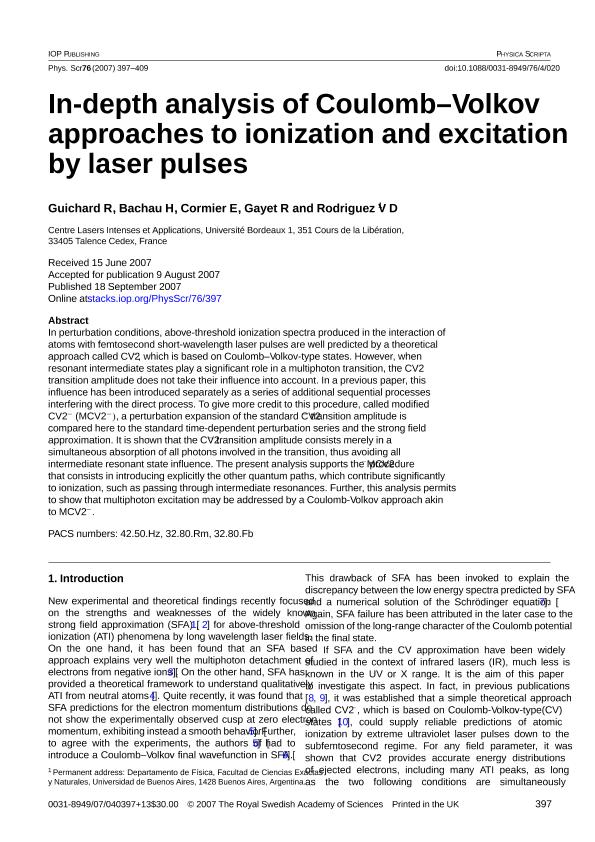Mostrar el registro sencillo del ítem
dc.contributor.author
Guichard, R.
dc.contributor.author
Bachau, H.
dc.contributor.author
Cormier, E.
dc.contributor.author
Gayet, R.
dc.contributor.author
Rodríguez Chariarse, Vladimir Daniel

dc.date.available
2019-01-07T15:26:41Z
dc.date.issued
2007-12
dc.identifier.citation
Guichard, R.; Bachau, H.; Cormier, E.; Gayet, R.; Rodríguez Chariarse, Vladimir Daniel; In-depth analysis of Coulomb–Volkov approaches to ionization and excitation by laser pulses; IOP Publishing; Physica Scripta; 76; 4; 12-2007; 397-409
dc.identifier.issn
0031-8949
dc.identifier.uri
http://hdl.handle.net/11336/67525
dc.description.abstract
In perturbation conditions, above-threshold ionization spectra produced in the interaction of atoms with femtosecond short-wavelength laser pulses are well predicted by a theoretical approach called CV2<sup>-</sup>, which is based on Coulomb–Volkov-type states. However, when resonant intermediate states play a significant role in a multiphoton transition, the CV2<sup>-</sup> transition amplitude does not take their influence into account. In a previous paper, this influence has been introduced separately as a series of additional sequential processes interfering with the direct process. To give more credit to this procedure, called modified CV2<sup>-</sup> (MCV2<sup>-</sup>), a perturbation expansion of the standard CV2<sup>-</sup> transition amplitude is compared here to the standard time-dependent perturbation series and the strong field approximation. It is shown that the CV2<sup>-</sup> transition amplitude consists merely in a simultaneous absorption of all photons involved in the transition, thus avoiding all intermediate resonant state influence. The present analysis supports the MCV2<sup>-</sup> procedure that consists in introducing explicitly the other quantum paths, which contribute significantly to ionization, such as passing through intermediate resonances. Further, this analysis permits to show that multiphoton excitation may be addressed by a Coulomb-Volkov approach akin to MCV2<sup>-</sup>.
dc.format
application/pdf
dc.language.iso
eng
dc.publisher
IOP Publishing

dc.rights
info:eu-repo/semantics/openAccess
dc.rights.uri
https://creativecommons.org/licenses/by-nc-sa/2.5/ar/
dc.subject.classification
Astronomía

dc.subject.classification
Ciencias Físicas

dc.subject.classification
CIENCIAS NATURALES Y EXACTAS

dc.title
In-depth analysis of Coulomb–Volkov approaches to ionization and excitation by laser pulses
dc.type
info:eu-repo/semantics/article
dc.type
info:ar-repo/semantics/artículo
dc.type
info:eu-repo/semantics/publishedVersion
dc.date.updated
2019-01-02T19:33:04Z
dc.journal.volume
76
dc.journal.number
4
dc.journal.pagination
397-409
dc.journal.pais
Reino Unido

dc.journal.ciudad
Londres
dc.description.fil
Fil: Guichard, R.. Universite de Bordeaux; Francia
dc.description.fil
Fil: Bachau, H.. Universite de Bordeaux; Francia
dc.description.fil
Fil: Cormier, E.. Universite de Bordeaux; Francia
dc.description.fil
Fil: Gayet, R.. Universite de Bordeaux; Francia
dc.description.fil
Fil: Rodríguez Chariarse, Vladimir Daniel. Consejo Nacional de Investigaciones Científicas y Técnicas. Oficina de Coordinación Administrativa Ciudad Universitaria. Instituto de Física de Buenos Aires. Universidad de Buenos Aires. Facultad de Ciencias Exactas y Naturales. Instituto de Física de Buenos Aires; Argentina
dc.journal.title
Physica Scripta

dc.relation.alternativeid
info:eu-repo/semantics/altIdentifier/url/http://www.iop.org/EJ/abstract/1402-4896/76/4/020
dc.relation.alternativeid
info:eu-repo/semantics/altIdentifier/doi/http://dx.doi.org/10.1088/0031-8949/76/4/020
Archivos asociados
